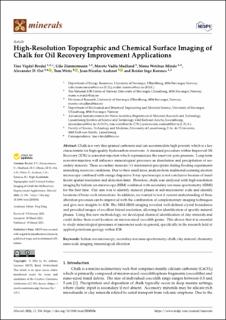| dc.contributor.author | Bredal, Tine Vigdel | |
| dc.contributor.author | Zimmermann, Udo | |
| dc.contributor.author | Madland, Merete Vadla | |
| dc.contributor.author | Minde, Mona Wetrhus | |
| dc.contributor.author | Ost, Alexander D. | |
| dc.contributor.author | Wirtz, Tom | |
| dc.contributor.author | Audinot, Jean-Nicolas | |
| dc.contributor.author | Korsnes, Reidar Inge | |
| dc.date.accessioned | 2022-06-14T11:26:50Z | |
| dc.date.available | 2022-06-14T11:26:50Z | |
| dc.date.created | 2022-04-02T13:29:10Z | |
| dc.date.issued | 2022-03 | |
| dc.identifier.citation | Bredal, T., Zimmermann, U., Madland, M., Minde, M., Ost, A., Wirtz, T., Audinot, J.-N., & Korsnes, R. (2022). High-Resolution Topographic and Chemical Surface Imaging of Chalk for Oil Recovery Improvement Applications. Minerals, 12(3), 356. | en_US |
| dc.identifier.issn | 2075-163X | |
| dc.identifier.uri | https://hdl.handle.net/11250/2998684 | |
| dc.description.abstract | Chalk is a very fine-grained carbonate and can accommodate high porosity which is a key characteristic for high-quality hydrocarbon reservoirs. A standard procedure within Improved Oil Recovery (IOR) is seawater-injection which repressurizes the reservoir pore pressure. Long-term seawater-injection will influence mineralogical processes as dissolution and precipitation of secondary minerals. These secondary minerals (<1 micrometer) precipitate during flooding experiments mimicking reservoir conditions. Due to their small sizes, analysis from traditional scanning electron microscopy combined with energy dispersive X-ray spectroscopy is not conclusive because of insufficient spatial resolution and detection limit. Therefore, chalk was analyzed with high-resolution imaging by helium ion microscopy (HIM) combined with secondary ion mass spectrometry (SIMS) for the first time. Our aim was to identify mineral phases at sub-micrometer scale and identify locations of brine–rock interactions. In addition, we wanted to test if current understanding of these alteration processes can be improved with the combination of complementary imaging techniques and give new insights to IOR. The HIM-SIMS imaging revealed well-defined crystal boundaries and provided images of excellent lateral resolution, allowing for identification of specific mineral phases. Using this new methodology, we developed chemical identification of clay minerals and could define their exact location on micron-sized coccolith grains. This shows that it is essential to study mineralogical processes at nanometer scale in general, specifically in the research field of applied petroleum geology within IOR. | en_US |
| dc.language.iso | eng | en_US |
| dc.publisher | MDPI | en_US |
| dc.rights | Navngivelse 4.0 Internasjonal | * |
| dc.rights.uri | http://creativecommons.org/licenses/by/4.0/deed.no | * |
| dc.subject | Improved Oil Recovery | en_US |
| dc.subject | petroleumsteknologi | en_US |
| dc.subject | chalk | en_US |
| dc.title | High-Resolution Topographic and Chemical Surface Imaging of Chalk for Oil Recovery Improvement Applications | en_US |
| dc.title.alternative | High-Resolution Topographic and Chemical Surface Imaging of Chalk for Oil Recovery Improvement Applications | en_US |
| dc.type | Peer reviewed | en_US |
| dc.type | Journal article | en_US |
| dc.description.version | publishedVersion | en_US |
| dc.rights.holder | © 2022 by the authors. | en_US |
| dc.subject.nsi | VDP::Teknologi: 500::Berg‑ og petroleumsfag: 510 | en_US |
| dc.source.volume | 12 | en_US |
| dc.source.journal | Minerals | en_US |
| dc.source.issue | 3 | en_US |
| dc.identifier.doi | 10.3390/min12030356 | |
| dc.identifier.cristin | 2014792 | |
| dc.source.articlenumber | 356 | en_US |
| cristin.ispublished | true | |
| cristin.fulltext | original | |
| cristin.qualitycode | 1 | |

